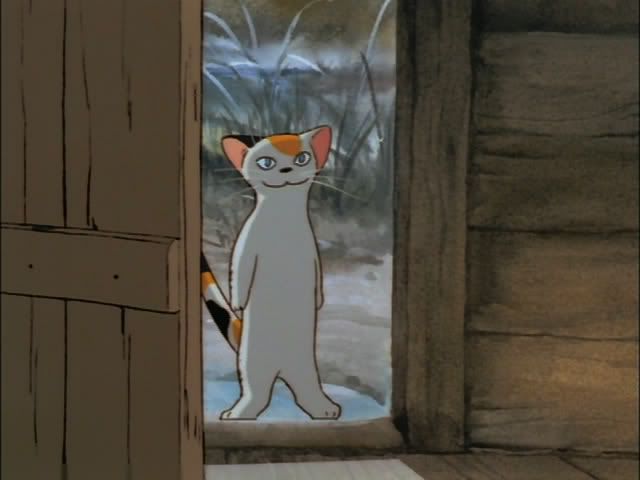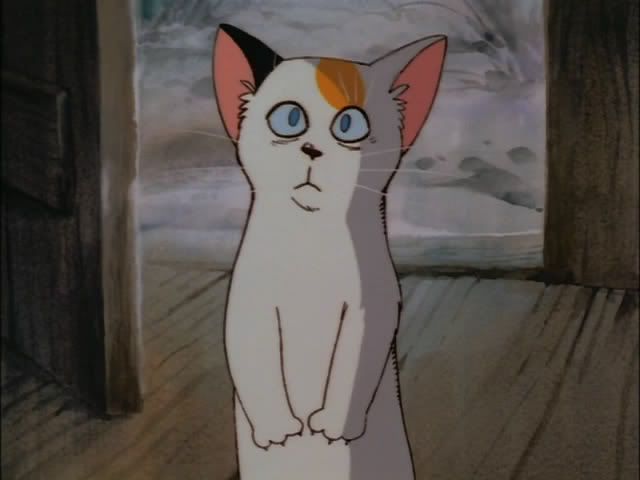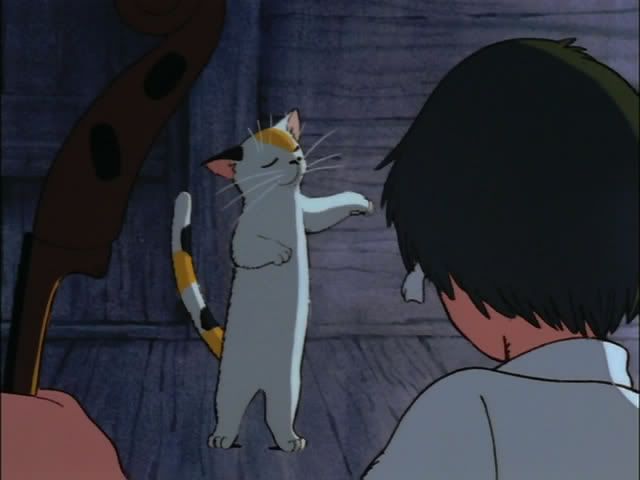Jex
Member
[Gauche the Cellist - Movie]
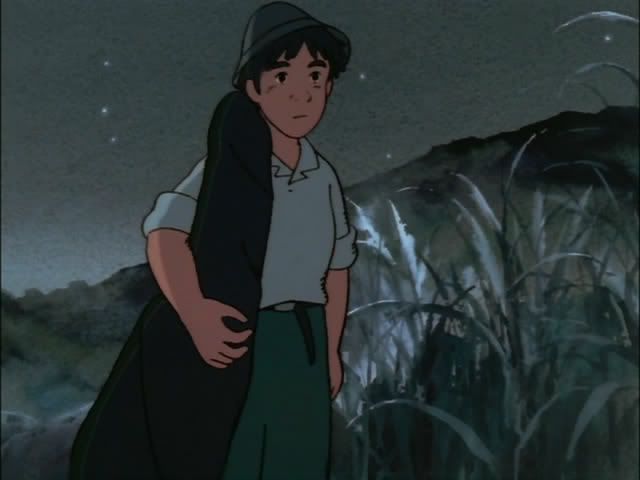
This is a movie about a guy named Gauche, pictured above. As you can see, hes a pretty average fella. He plays the cello in a small local orchestra, but hes not really anything special. He doesnt dream of conquering the world stage or changing the face of music, he just practices the cello diligently for an upcoming concert. Along the way he gets some help from some unusual places.
Thats the whole movie, basically. You should all watch it! It's kind of hard to explain why, as there isn't really any wacky 'hooks'. Most of the film is based on visuals and music, not story or character. I guess the best reason to watch it is because it's a thoroughly enjoyable experience. It's just fun.
Its really short too, with a 60 minute run time. That all might sound incredibly boring and maybe it would have been if it hadnt been directed by the Studio Ghibli veteran Isao Takahata. Thanks to his talents this movie is an incredibly polished gem. I dont think theres a single thing wrong with the way this movie is made, which is a pretty rare state of affairs, because of this level of craftsmanship the film is simply a joy to watch. This is especially true in how skilfully audio and visual elements are mixed together. Yes, the story is very basic, but that means that its also easy to connect with and enjoy.
Of course, this means that unlike certain Takahata works, like Grave of the Fireflies, this is the kind of movie that anyone could enjoy, its certainly fair game for the whole family. It's not even steeped in genre tropes, it's really an accessible piece.

If youll allow me to talk briefly about how the film is put together, there are quite a few things to talk about. Firstly theres the excellent character animation. As the scale of the action is so mundane and small the animators really go town in creating beautiful motion for all the characters, whatever the species. This really sells the movie as a whole in a way you might not notice as you're watching, but would be painfully apparent if it wasn't present.
With such an incredibly basic premise, very few developed characters and no fancy location theres very little to for a director hide behind. The question then becomes, how do you make a guy playing music all day in his shack, and occasionally in other locations, interesting enough for an audience? Shockingly enough, theres no easy solution, but luckily theres some room to get creative if you try really hard.

For example, you have the orchestra playing during a storm, but then this merges into them literally playing inside the storm, becoming one with its howling winds and lashing rain. This scene only works because its subtle; the editing makes the transition feel natural, rather than painfully abrupt. This scene could have just been the orchestra playing in the storm, edited against particularly dramatic bouts of lightning, or something. That would be the easy way to do it, at least. Here though, Takahata went for a more interesting approach. This is present throughout the film in a number of ways, some obvious and some subtle. Individually these scenes are noteworthy, but when the movie strings them together on a fairly continuous basis it starts to become fairly impressive. All the minor details really work together to make a very cohesive and satisfying movie on a visual and aural level, which is essential when making a movie all about music.
Also, that dammed cat! Look how smug he appears!
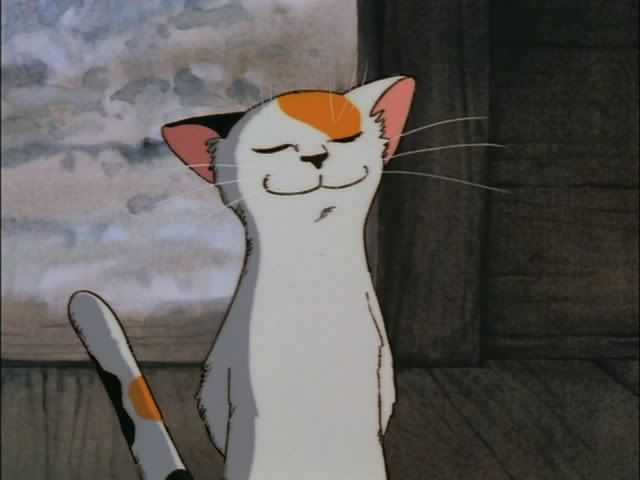

This is a movie about a guy named Gauche, pictured above. As you can see, hes a pretty average fella. He plays the cello in a small local orchestra, but hes not really anything special. He doesnt dream of conquering the world stage or changing the face of music, he just practices the cello diligently for an upcoming concert. Along the way he gets some help from some unusual places.
Thats the whole movie, basically. You should all watch it! It's kind of hard to explain why, as there isn't really any wacky 'hooks'. Most of the film is based on visuals and music, not story or character. I guess the best reason to watch it is because it's a thoroughly enjoyable experience. It's just fun.
Its really short too, with a 60 minute run time. That all might sound incredibly boring and maybe it would have been if it hadnt been directed by the Studio Ghibli veteran Isao Takahata. Thanks to his talents this movie is an incredibly polished gem. I dont think theres a single thing wrong with the way this movie is made, which is a pretty rare state of affairs, because of this level of craftsmanship the film is simply a joy to watch. This is especially true in how skilfully audio and visual elements are mixed together. Yes, the story is very basic, but that means that its also easy to connect with and enjoy.
Of course, this means that unlike certain Takahata works, like Grave of the Fireflies, this is the kind of movie that anyone could enjoy, its certainly fair game for the whole family. It's not even steeped in genre tropes, it's really an accessible piece.

If youll allow me to talk briefly about how the film is put together, there are quite a few things to talk about. Firstly theres the excellent character animation. As the scale of the action is so mundane and small the animators really go town in creating beautiful motion for all the characters, whatever the species. This really sells the movie as a whole in a way you might not notice as you're watching, but would be painfully apparent if it wasn't present.
With such an incredibly basic premise, very few developed characters and no fancy location theres very little to for a director hide behind. The question then becomes, how do you make a guy playing music all day in his shack, and occasionally in other locations, interesting enough for an audience? Shockingly enough, theres no easy solution, but luckily theres some room to get creative if you try really hard.

For example, you have the orchestra playing during a storm, but then this merges into them literally playing inside the storm, becoming one with its howling winds and lashing rain. This scene only works because its subtle; the editing makes the transition feel natural, rather than painfully abrupt. This scene could have just been the orchestra playing in the storm, edited against particularly dramatic bouts of lightning, or something. That would be the easy way to do it, at least. Here though, Takahata went for a more interesting approach. This is present throughout the film in a number of ways, some obvious and some subtle. Individually these scenes are noteworthy, but when the movie strings them together on a fairly continuous basis it starts to become fairly impressive. All the minor details really work together to make a very cohesive and satisfying movie on a visual and aural level, which is essential when making a movie all about music.
Also, that dammed cat! Look how smug he appears!


